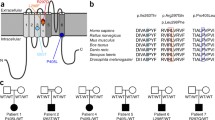Abstract
The α4-subunit gene (CHRNA4) of the neuronal nicotinic acetylcholine receptor (nAChR) subunit family has recently been identified in two families as the gene responsible for autosomal dominant nocturnal frontal lobe epilepsy (ADNFLE), a rare monogenic idiopathic epilepsy. As a result of this finding, other subunits of the neuronal nAChR gene family are being considered as candidate genes for ADNFLE in families not linked to CHRNA4 and for other idiopathic epilepsies. α4-subunitsoften assemble together with β2-subunits (gene symbol CHRNB2) to build heteromeric nAChRs. The gene encoding another abundant AChR subunit, the α3-subunit gene (CHRNA3), is present with those encoding two other subunits, CHRNB4 and CHRNA5, in a gene cluster whose functional role is still unclear. Here we provide the information on the genomic structures of both the CHRNB2 and the CHRNA3 genes that is necessary for comprehensive mutational analyses, and we refine the genomic assignment of CHRNB2 on chromosome 1.
Similar content being viewed by others
Author information
Authors and Affiliations
Additional information
Received: 5 August 1998 / Accepted: 13 October 1998
Rights and permissions
About this article
Cite this article
Rempel, N., Heyers, S., Engels, H. et al. The structures of the human neuronal nicotinic acetylcholine receptor β2- and α3-subunit genes (CHRNB2 and CHRNA3). Hum Genet 103, 645–653 (1998). https://doi.org/10.1007/s004390050885
Issue Date:
DOI: https://doi.org/10.1007/s004390050885




